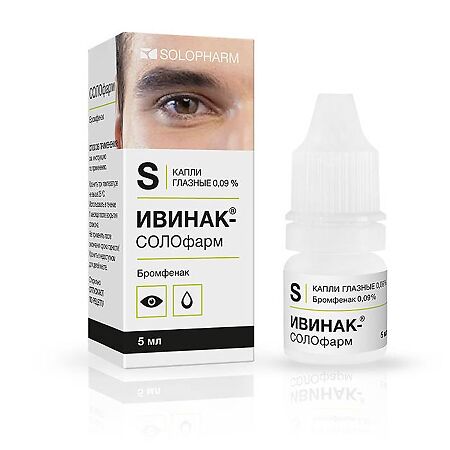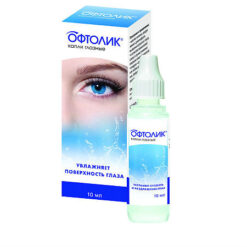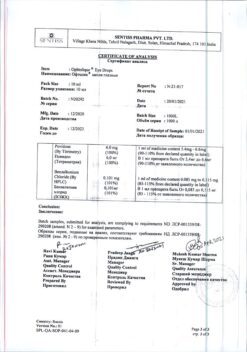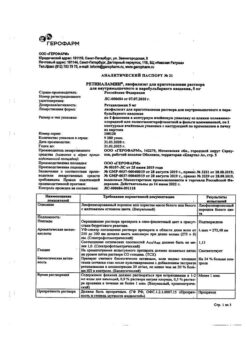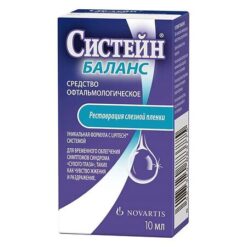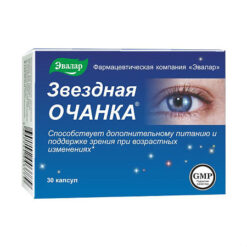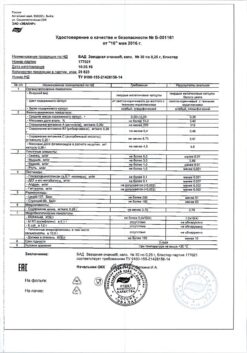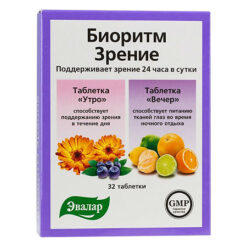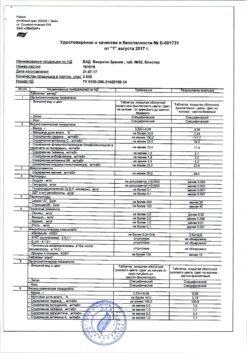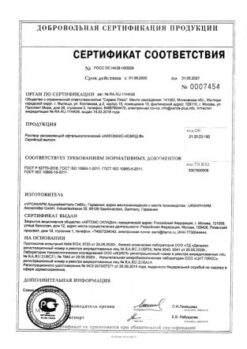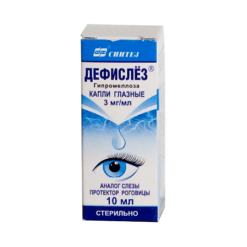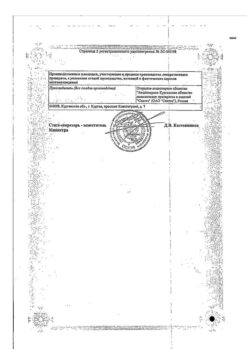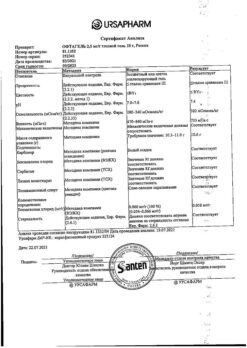No products in the cart.
Ivinac-Solofarm, eye drops 0.09% 5 ml
€1.00
Out of stock
(E-mail when Stock is available)
Description
Pharmacotherapeutic group
A nonsteroidal anti-inflammatory drug (NSAID).
ATX code:
S01BC11
Pharmacological properties
/strong>
Pharmacodynamics
Bromfenac is a non-steroidal anti-inflammatory drug (NSAID), the anti-inflammatory effect of which is realized by blocking the synthesis of prostaglandins while inhibiting cyclooxygenase 1 and 2.
In in vitro studies, bromfenac inhibited prostaglandin synthesis in the ciliary body of the rabbit. The concentration of half-maximal inhibition (IC50) was lower for bromfenac (1.1 μmol) than for indomethacin (4.2 μmol) and pranoprofen (11.9 μmol).
In an experimental model of uveitis in rabbits, bromfenac at concentrations of 0.02%, 0.05%, 0.1% and 0.2% inhibited virtually all symptoms of ocular inflammation.
Pharmacokinetics
absorption
Bromfenac effectively penetrates through the cornea of cataract patients: When administered once, the average peak concentration in aqueous humor is 79±68 ng/mL 150-180 minutes after administration. This concentration persists for 12 hours in the aqueous humor with measurable concentration levels in major ocular tissues, including the retina, for up to 24 hours. When bromfenac eye drops were administered twice daily, plasma concentrations were not quantifiable.
Distribution
Bromfenac actively binds to plasma proteins. According to a in vitro study, the binding to human plasma proteins was 99.8%.
The in vitro study showed no biologically significant binding to melanin.
According to studies in rabbits using radiolabeled bromfenac the maximum concentration after topical application is observed in the cornea, high – in the conjunctiva and aqueous humor of the eye. Low – in the lens and vitreous body.
Metabolism
According to in vitro studies, the main metabolism of bromfenac is performed by the enzyme CYP2C9, which is absent in the iridociliary zone, retina and vasculature. The level of this enzyme in the cornea is less than 1% compared to the corresponding hepatic level.
On oral administration in humans, the unchanged original substance is mostly detected in plasma. Several conjugated and unconjugated metabolites have been identified, the main one being cyclic amide, which is excreted in the urine.
Elimation
When injected into the eye, the half-life of bromfenac from the aqueous humor of the eye is about 1.4 hours, indicating rapid elimination.
After oral administration of 14C-bromfenac in healthy volunteers, the drug was found to be primarily excreted in the urine (about 82% of the administered dose), while about 13% of the administered dose was excreted in the feces.
Indications
Indications
Treatment of non-infectious inflammatory diseases of the anterior segment of the eye and postoperative inflammation (after cataract extraction, etc.).
Active ingredient
Active ingredient
Composition
Composition
Active ingredient: Bromfenac sodium sesquihydrate 1.035 mg, in terms of bromfenac 0.9 mg
Auxiliary substances:
How to take, the dosage
How to take, the dosage
Instillation into the conjunctival sac.
1 to 2 drops of the drug in the conjunctival sac twice daily for no more than 15 days.
If a dose of the drug is missed, it should be used as soon as possible in the dosage indicated in the instructions for use. If a missed dose of the medication is about 24 hours, the medication should be used at the next scheduled time, without doubling the dose to compensate for the missed dose.
Treatment of postoperative inflammation: one drop once a day. Treatment begins 1 day before surgery and continues for the first 14 days of the postoperative period (including the day of surgery).
Treatment of non-infectious inflammatory diseases of the anterior segment of the eye: one drop twice a day. The course of treatment is determined by the doctor depending on the severity of the condition.
Performance of the bottle (without the stopper):
Performance with Bottle with Stopper:
The product should not be used if the vial is visibly damaged.
Interaction
Interaction
Special Instructions
Special Instructions
The drug should be used for symptomatic treatment, not for etiotropic therapy.
The drug should only be used as eye drops.
All topical NSAIDs may delay or delay healing similar to topical glucocorticosteroids. Combined use of NSAIDs and topical steroids may increase the likelihood of healing problems.
Cross-sensitivity
There is a possibility of cross-sensitivity to acetylsalicylic acid, phenylacetic acid derivatives and other NSAIDs. Therefore, caution should be exercised when treating individuals who have a history of sensitivity to these drugs, and the potential risks and benefits should be carefully evaluated.
Special patient groups
. In susceptible patients, long-term use of topical NSAIDs, including bromfenac, may result in epithelial tearing, corneal thinning, corneal erosion, corneal ulceration or corneal perforation. These events can threaten vision loss. Patients with signs of corneal epithelial destruction should immediately discontinue use of topical NSAIDs and should be closely monitored for corneal health. Consequently, in patients at risk, concomitant use of ophthalmic corticosteroids with NSAIDs may result in an increased risk of corneal adverse events.
Post-registration experience
. Post-registration experience with topical NSAIDs indicates that patients with complications from ophthalmic surgery, corneal denervation, corneal epithelial defects, diabetes and superficial eye disease, rheumatoid arthritis, or repeated ophthalmic surgery performed within a short period of time may have an increased risk of corneal adverse events that may become threatening visual loss. Topical NSAIDs should be used with caution in these patients.
It has been reported that ophthalmic NSAIDs may cause increased ocular tissue bleeding (including hyphema) in conjunction with ophthalmic surgery. Topical NSAIDs should be used with caution in patients with a history of bleeding tendencies or if patients are receiving other medications that may increase clotting time.
Eye infections
The use of the drug should be carefully monitored and patients with inflammation caused by infections should be prescribed with caution, as the drug may mask the symptoms of eye infections.
Contact lens use
In general, contact lens wear is not recommended during drug treatment. Because of this, patients are not recommended to wear contact lenses unless clearly instructed by their physician.
Associates
Benzalkonium chloride, which is often used in ophthalmic preparations as a preservative, may cause pitting keratopathy and/or toxic ulcerative keratopathy. Because the drug contains benzalkonium chloride, close monitoring is required for frequent or prolonged use in patients with dry eye syndrome or in cases of corneal damage. Benzalkonium chloride may discolor soft contact lenses. It is necessary to remove soft contact lenses before application and put them on again 15 minutes after injection.
Influence on ability to drive vehicles and machinery
Transient blurring of vision may occur after instillation. If blurred vision develops after instillation, refrain from driving vehicles and machinery until clarity of vision is restored.
Synopsis
Synopsis
Contraindications
Contraindications
The drug is contraindicated in patients with a history of hypersensitivity to any component of the drug.
The drug is contraindicated in patients with attacks of bronchial asthma, urticaria and symptoms of acute rhinitis when taking acetylsalicylic acid and other NSAIDs.
The age under 18 years (the safety and effectiveness in children has not been studied).
Side effects
Side effects
Overdose
Overdose
There is currently no information on overdose when administered topically in humans.
According to foreign reports, serious liver function abnormalities (including deaths) have been observed in patients who have taken bromfenac sodium orally in a total dose exceeding 1500 mg for an extended period of more than 1 month. Therefore, if abnormalities that are suspected to be associated with early symptoms of liver failure are detected, treatment with this drug should be discontinued and appropriate measures taken.
Pregnancy use
Pregnancy use
Sufficient data on the use of bromfenac in pregnant women are not available. Animal studies have demonstrated reproductive toxicity. The potential risk to humans is unknown. Because systemic effects after treatment with the drug in nonpregnant women are negligible, the risk during pregnancy can be considered low.
Similarities
Similarities
Additional information
| Shelf life | 3 years. After opening the bottle – 1 month. Do not use after the expiration date! |
|---|---|
| Conditions of storage | At a temperature not higher than 25 ° C. Keep out of reach of children. |
| Manufacturer | Grotex Ltd, Russia |
| Medication form | eye drops |
| Brand | Grotex Ltd |
Related products
Buy Ivinac-Solofarm, eye drops 0.09% 5 ml with delivery to USA, UK, Europe and over 120 other countries.

